
Catalog excerpts

Command Line Configuration of Seamless Redundancy (IEEE 802.1CB) Application Note Security Document number Version Date Status TTTech Industrial Automation AG Schonbrunner Str. 7, 1040 Vienna, Austria, Tel. +43 1 585 34 34–0, Fax +43 1 585 34 34–90, ̈ support@tttech-industrial.com © 2021 TTTech Industrial Automation AG. All rights reserved. Subject to changes and correcti
Open the catalog to page 1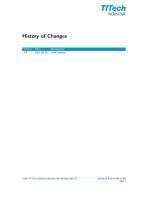
History of Changes Version 1.0 Modification initial version © 2021 TTTech Industrial Automation AG. All rights reserved.
Open the catalog to page 2
1 Test Setup Goal of this example is to configure a seamless, redundant connection between two DE-IP Evaluation Boards (#13122) using the frame replication and elimination features defined within the IEEE 802.1CB-2017 standard. As hardware two Evaluation Boards, two PCs and a separate engineering PC are used. The following figure depicts the complete hardware setup, topology, and most important configuration parameters: Figure 1.1: testsetup overview It is assumed that all devices are already configured as members of a common test network 192.168.0.0/24. Please make sure that all your...
Open the catalog to page 3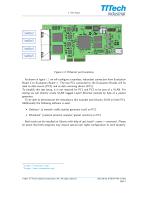
Figure 1.2: Ethernet port locations As shown in figure 1.1 we will configure a seamless, redundant connection from Evaluation Board 2 to Evaluation Board 1. The two PCs connected to the Evaluation Boards will be used as data source (PC2) and as data receiving device (PC1). To simplify this test setup, it is not required for PC1 and PC2 to be part of a VLAN. For testing we will directly create VLAN tagged Layer2 Ethernet packets by help of a packet generator. To be able to demonstrate the redundancy this example uses Ubuntu 20.04 on both PCs. Additionally the following software is used: •...
Open the catalog to page 4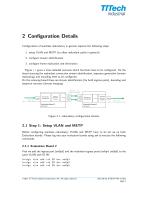
2 Configuration Details Configuration of seamless redundancy in general requires the following steps: 1. setup VLAN and MSTP (to allow redundant paths in general) 2. configure stream identification 3. configure frame replication and elimination Figure 2.1 gives a more detailed overview which functions have to be configured. On the board sourcing the redundant connection stream identification, sequence generation (stream replicating) and encoding need to be configured. On the receiving board these are stream identification (for both ingress ports), decoding and sequence recovery (stream...
Open the catalog to page 5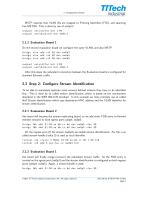
MSTP requires that VLAN IDs are mapped to Filtering Identifiers (FID), and spanning tree MSTIDs. This is done by use of mstpctl. mstpctl s e t v i d 2 f i d br0 1:99 mstpctl s e t f i d 2 m s t i d br0 4094:1 2.1.2 Evaluation Board 1 On the second evaluation board we configure the same VLANs and also MSTP. b r i d g e v l a n add v i d 99 dev sw0p3 b r i d g e v l a n add v i d 99 dev sw0p4 b r i d g e v l a n add v i d 99 dev sw0p5 mstpctl s e t v i d 2 f i d br0 1:99 mstpctl s e t f i d 2 m s t i d br0 4094:1 After this steps the redundant connection between the Evaluation boards is...
Open the catalog to page 6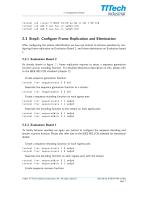
t s n t o o l s i d c r e a t e 5 NULL 0 1 : 0 0 : aa : bb : c c : dd 1 99 b r 0 t s n t o o l s i d add 5 out−f a c −i n sw0p4 b r 0 t s n t o o l s i d add 5 out−f a c −i n sw0p5 b r 0 2.3 Step3: Configure Frame Replication and Elemination After configuring the stream identification we now use tsntool to become seamless by configuring frame replication on Evaluation Board 2, and frame elemination on Evaluation board 1. 2.3.1 Evaluation Board 2 As already shown in figure 2.1 frame replication requires to setup a sequence generation function and an encoding function. For...
Open the catalog to page 7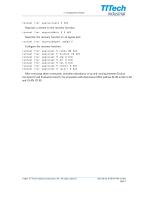
Associate a stream to the recovery function: t s n t o o l f r e r s e q r e c a d d s t r 5 5 br0 Associate the recovery function to an egress port: t s n t o o l f r e r s e q r e c a d d p o r t sw0p3 5 Configure the recovery function: tsntool tsntool tsntool tsntool tsntool tsntool tsntool frer frer frer frer frer frer frer seqrecset seqrecset seqrecset seqrecset seqrecset seqrecset seqrecset After executing these commands, seamless redundancy is up and running between Evaluation board 2 and Evaluation board 1 for all packets with destination MAC address 01:00:aa:bb:cc:dd and VLAN ID...
Open the catalog to page 8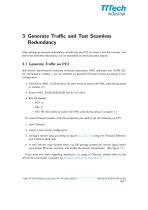
3 Generate Traffic and Test Seamless Redundancy After setting up seamless redundancy, we will now use PC2 to create a test data stream, and show how seamless redundancy can be monitored on the Evaluation boards. 3.1 Generate Traffic on PC2 Null-Stream identification evaluates multicast destination MAC addresses and VLAN IDs. As mentioned in chapter 1 we use Ostinato to generate Ethernet frames according to our configuration: • Destination MAC: 01:00:aa:bb:cc:dd (this needs to match the MAC used during setup in chapter 2.) • Source MAC: 00:00:00:00:00:00 (we do not care) • 802.1Q Header: –...
Open the catalog to page 9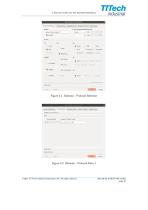
3 Generate Traffic and Test Seamless Redundancy Figure 3.1: Ostinato - Protocol Selection Figure 3.2: Ostinato - Protocol Data 1 © 2021 TTTech Industrial Automation AG. All rights reserved.
Open the catalog to page 10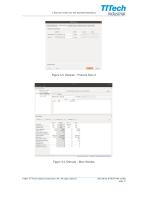
3 Generate Traffic and Test Seamless Redundancy Figure 3.3: Ostinato - Protocol Data 2 Figure 3.4: Ostinato - Main Window © 2021 TTTech Industrial Automation AG. All rights reserved.
Open the catalog to page 11
3 Generate Traffic and Test Seamless Redundancy 3.2 Monitor Evaluation Boards Statistic Counters While Ostinato is generating packets on your PC1, you can use tsntool to read out status and counter values for stream identification and frame recovery. The following commands can be used for this: On Evaluation Board 2 (replicating device): t s n t o o l s i d show b r 0 5 t s n t o o l s i d cn tsh ow sw0p3 5 On Evaluation Board 1 (recovering device): tsntool tsntool tsntool tsntool tsntool By using these commands, you can compare e.g. the number of incoming packets on Evaluation Board 2...
Open the catalog to page 12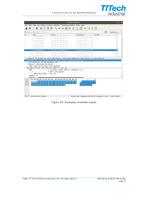
3 Generate Traffic and Test Seamless Redundancy Figure 3.6: Exemplary wireshark output © 2021 TTTech Industrial Automation AG. All rights reserved.
Open the catalog to page 13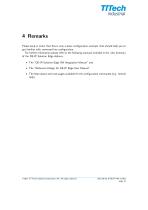
4 Remarks Please keep in mind, that this is only a basic configuration example, that should help you to get familiar with command line configuration. For further information please refer to the following manuals included in the /doc directory of the DE-IP Solution Edge delivery: • The “DE-IP-Solution-Edge SW Integration Manual” and • The “Reference Design for DE-IP Edge User Manual” • The help output and man-pages available for the configuration commands (e.g. tsntool help) © 2021 TTTech Industrial Automation AG. All rights reserved.
Open the catalog to page 14All TTTech Industrial Automation AG catalogs and technical brochures
-
TSN Starter Package
2 Pages
-
Who we are and what we do
2 Pages





